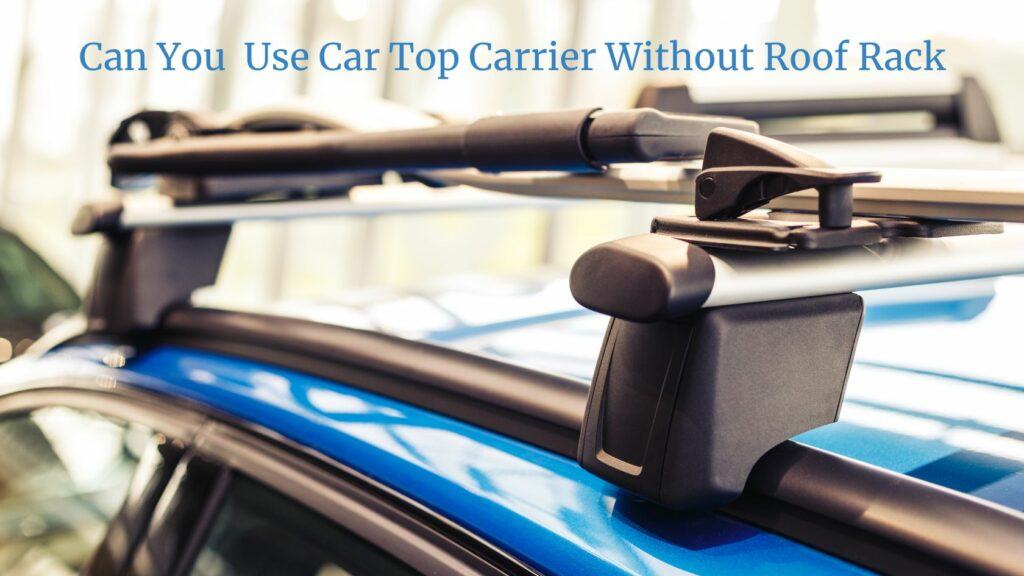
Today, I’m going to be talking about car top carriers, those handy devices that let you pack more and hit the road with everything you might need. You’ll find out about the incredible versatility these carriers offer for everything from camping trips to moving days.
So what is a car top carrier? It’s essentially a storage box or bag that sits on top of your car. They come in all shapes and sizes, from hardshell cases that protect your gear from the elements to soft, flexible bags that can accommodate irregularly shaped items.
Traditionally, roof racks have been considered a must-have when using car top carriers. These racks provide a stable platform to secure the carrier and its contents. However not everyone has a roof rack, and not all vehicles come equipped with them. This raises important questions about feasibility and safety.
Can You Use A Car Top Carrier Without A Roof Rack?
Yes, you can use a car-top carrier without a roof rack by opting for soft or inflatable carriers designed for such use.
These carriers attach directly to your car using durable straps and hooks, often secured through the car doors or to the car’s frame.
It’s essential to use a non-slip protective mat between the carrier and the car roof to prevent scratches and shifting. Ensure the load is evenly distributed and within the weight limit of your car’s roof.
For security, some carriers feature lockable zippers. Weatherproofing is also important for protecting your belongings. Follow the manufacturer’s instructions for installation, and periodically check the carrier’s attachments during travel. This setup allows for the safe and effective use of a car top carrier without a roof rack.
Do I Need a Roof Rack For a Cargo Carrier?
You might be also asking yourself, ‘Does every carrier out there necessitate a rack on top of my vehicle?’ The short answer is, it depends. Let’s get into the specifics.
Cargo carriers generally come designed to be mounted on roof racks. Why? Because they provide a sturdy and secure platform for your belongings. If you’re planning on loading up with heavy or bulky items, a roof unfit for a carrier could lead to damage or even accidents.
However, not every trip with a cargo carrier means you’re loading up heavy gear. For lighter loads, some carriers are designed with flexibility in mind and can rest safely on your car’s roof with the right protective measures and non-permanent fixtures.
But don’t worry too much about the technicalities just yet. Using a cargo carrier without a roof rack is all about making the right choice to match your vehicle’s capabilities and understanding the alternative methods of attachment, which we’re going to cover next.
Also, think about the long run. Sure, a roof rack is an extra investment. But if you’re hauling cargo often, it’s worth considering the enhanced stability and protection it offers. It’s a trade-off between initial convenience and recurring peace of mind.
This isn’t just about whether you can; it’s also about whether you should. If you’re a stickler for safety and efficiency, a roof rack might align well with your outlook. On the other hand, for the casual user, non-rack options might be the way to go.
Attaching a Car Top Carrier Without a Roof Rack
I’m going to walk you through how you can secure a car top carrier even if your vehicle doesn’t come with a roof rack.
First things first, you’ll need to get your hands on the right tools and materials. We’re talking about non-skid mats, sturdy straps, and possibly a set of car clips designed for your particular carrier.
Now, you’re going to find out about protecting your car’s finish. It’s crucial because the last thing you want is scratches or dents from a poorly installed carrier. A non-skid mat not only adds cushioning but also helps distribute the weight of the carrier evenly.
Securing the carrier securely is the next big step. If you’re using straps, they should run through the vehicle’s doors or windows, fastened tightly to ensure the carrier won’t shift around while you’re driving. Always double-check to make sure everything’s rock solid before you hit the road.
You can always adjust your approach down the road, but for maintenance and safety, regularly inspect your setup. Make sure the straps haven’t loosened and that the carrier hasn’t shifted. Regular checks will give you peace of mind and keep you safe on your travels.
Here’s a short and simple video on attaching a car rooftop carrier without a roof rack:
Exploring Roof Bag Alternatives: Can You Use a Roof Bag Without a Roof Rack?
So you’re curious about the practicality of a roof bag when you don’t have a roof rack. Well, these carriers offer a soft and flexible storage option that’s often more adaptable to different types of vehicle roofs. Now, isn’t that a relief?
Roof bags are specifically designed to work well with or without roof racks, making them a universally applicable choice for most car owners. I mean, who doesn’t love versatility? And when you choose a roof bag, you’re opting for something easy to store when not in use, unlike the more rigid traditional cargo carriers.
When picking out a roof bag, the key is to find one that’s compatible with your car. You should look for bags with sturdy straps and protective mats that help distribute the weight evenly and prevent slippage or damage to your car’s paint job.
Now, while the installation might differ slightly from the traditional setup, it’s often just a matter of following the given instructions carefully. Many roof bags come with easy-to-understand manuals that will guide you through the process. And guess what? They’re typically simpler to put on and take off, which is a plus if you’re always on the go.
Remember, even though there is the convenience of not needing a roof rack, safety is still paramount. I can’t stress enough the importance of double-checking the security of the straps and ensuring the load is balanced. Your manual will be your best friend here, outlining the specific tips to ensure a snug and secure fit.
Final thoughts
To wrap up, whether you opt for a traditional cargo carrier or a versatile roof bag, the key takeaway should be your confidence in safely transporting your stuff.
Choose something that resonates with you and your vehicle’s capabilities. And most importantly, don’t overpack or exceed the manufacturer’s recommended weight limits.
That way, you’ll be all set for a worry-free adventure with everything you need in tow. Have a great trip and drive safely!
